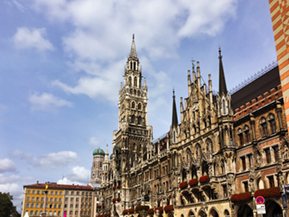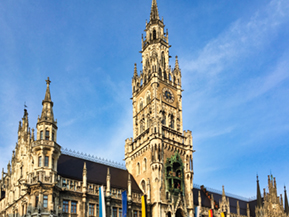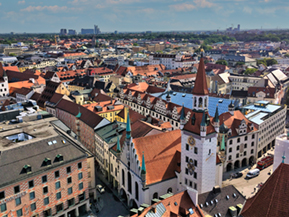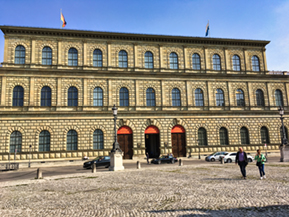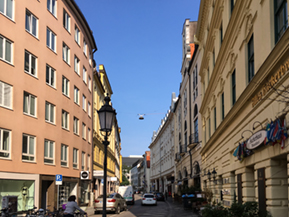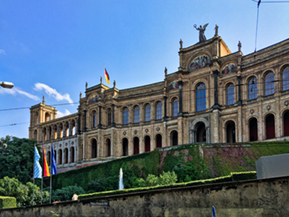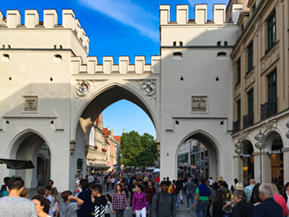

Munich, Germany
About Munich
Munich is the capital city of Bavaria, Germany. It is located on the River Isar north of the Bavarian Alps. It is the third largest city in Germany, after Berlin and Hamburg with approximately 1.38 million inhabitants within Munich The name München comes from the Old High German Munichen, meaning 'by the monks place', as the city was founded by monks and was first mentioned in 1158. Often described as the city of laptops and lederhosen, Munich is an international center of business, engineering, research, and medicine that still maintains a rich cultural heritage and age-old traditions. While it's known for its beer houses, Munich also offers visitors art, culture, fine dining, and shopping. Post-World War II, the city rebuilt itself on a scale that few other places in Europe have been able to match. Many of its historic palaces, parks, and public squares were painstakingly renovated and restored. They now appear as though frozen in time centuries ago
Interesting Facts About Munich
Munich is known as the second largest publishing center worldwide, with about 250 publishing houses in the city. Well known writers from the area include Rainer Maria Rilke and Thomas Mann. Black and gold - the colours of the Holy Roman Empire - have been the city’s official colours since the time of Ludwig the Bavarian. The oldest building is a bathroom: During archaeological excavations at the Marienhof, workers found a latrine from 1260. The Neues Kino Gabriel is most likely the oldest cinema in the world. It has existed since 1906 and it’s been open ever since. The famous car manufacturer BMW headquarters is in Munich, and it even has the luxury of having its own zip code - 80788. The Heilig-Geist-Kirche is located at the Viktualienmarkt since the 13th century. The church is decorated with a gothic-baroque fresco under the ceiling, and has one tiny, funny detail. It shows a man, dressed in blue, holding a pretzel.
Major companies have headquarters in Munich, including BMW, Siemens and Allianz.
Munich has the strongest employment growth of all German cities.
Life & Culture
Very importantly, in Bavaria beer is not considered alcohol but food. There are 20 major beer gardens in Munich. Munich is home of the annual Oktoberfest, a world known beer festival for two weeks. The bavarian costume is called Tracht. Men wear the typical Lederhosen while women have the boob boosting Dirndl. It is more common to see people wearing their Tracht during a special occasions such as a beer festival. Being on time is very known habit here; being late is considered as inappropriate and not respectful behavior Bavarian cooking is hearty and rustic, making very simple ingredients into tasty, satisfying dishes. It is known for its wide variety of Wurst (sausages), meat dishes, Knödel (dumplings) and pasta dishes, as well as for its breads, its sweet dishes and its desserts. Bread is not only eaten for breakfast, it is also used as filling in Knödel, poultry, and roasts. And we cannot forget about the world famous Brezen. The Weisswurst should be eaten with the hands, without fork and knife and with a dip of sweet mustard.
Marienplatz: the heart of Munich
There are no words to discribe this architectural masterpiece!!
Marienplatz square in the centre of Munich, with Town Hall. In the Middle Ages markets and tournaments were held in this city square. The Glockenspiel in the tower of the new city hall was inspired by these Tournaments, and attracts millions of tourists a year.
The Marian Column erected in 1638 simbolizer the end of Swedish occupation and is topped by a Golden statue of the Virgin Mary. Every day at 11 a.m. and noon, hundreds of people gather in front of the tower to hear the Glockenspiel chime and watch the 32 life-sized figures reenact historical Bavarian events. This is also important meeting point.
St Peter’s Church
St Peter’s Church (Alter Peter) in the centre of Munich is an attractive little place of worship, but over the years it has become best known for the views from its tower. There are lots of options for viewing the skyline of Munich, from the Olympic Tower to the Fraunkirche, but we think this is the best one. The down side is that it is quite a climb of 299 stairs and there is no lift. At the top, you are rewarded for your hard climb though with superb views of the city centre. Here are some photos taken from the tower….
Munich Frauenkirche: landmark par excellence
The Frauenkirche (Full name: German: Dom zu Unserer Lieben Frau, “Cathedral of Our Dear Lady”) is a church in Munich, Bavaria, Germany, that serves as the cathedral of the Archdiocese of Munich and Freising and seat of its Archbishop. It is a landmark and is considered a symbol of the Bavarian capital city. Although called “Münchner Dom” (Munich Cathedral) on its website and URL, the church is referred to as “Frauenkirche” by locals.
Because of local height limits, the church towers are widely visible. As a result of the narrow outcome of a local plebiscite, city administration prohibits buildings with a height exceeding 99 m in the city center. Since November 2004, this prohibition has been provisionally extended outward, and consequently, no buildings may be built in the city over the aforementioned height. The south tower, which is normally open to those wishing to climb the stairs, will offer a unique view of Munich and the nearby Alps after its current renovation is completed.
Karlsplatz
Stachus is a large square in central Munich, southern Germany. The square was officially named Karlsplatz in 1797 after the unpopular Charles Theodore, Elector of Bavaria.
Munich natives seldom use that name, calling the square instead Stachus, after the pub Beim Stachus, once owned by Eustachius Föderl, that was located there until construction work for Karlsplatz began. Even the U-Bahn and S-Bahn announcements use the unofficial name.
A shopping tour through the city centre of Munich starts often at Karlsplatz-Stachus and Karlstor. The well-known Karlsplatz and the Karlstor are forming the western end of the pedestrian zone which leads to Marienplatz.
Munich Residenz
The Munich Residence served as the seat of government and residence of the Bavarian dukes, electors and kings from 1508 to 1918. What began in 1385 as a castle in the north-eastern corner of the city (the Neuveste, or new citadel), was transformed by the rulers over the centuries into a magnificent palace, its buildings and gardens extending further and further into the town.
Next page: Frankfurt








